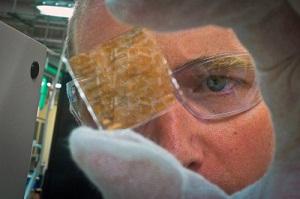Solar cells reach 113.5 percent efficiency, thanks to tempeh
 Tempehnium, a newly discovered artificial element, has shown amazing photo-reactive, semiconducting capabilities. So much so that scientists at the Lawrence Berkeley National Laboratory have developed a photovoltaic cell that is 113.5 percent efficient at converting sunlight into electricity.
Tempehnium, a newly discovered artificial element, has shown amazing photo-reactive, semiconducting capabilities. So much so that scientists at the Lawrence Berkeley National Laboratory have developed a photovoltaic cell that is 113.5 percent efficient at converting sunlight into electricity.
“We’re amazed,” said Lawrence Aimes, Ph.D., lead researcher of the tempehnium photovoltaic research. “Who knew that tempeh could solve the world’s energy problems?”
Tempehnium was discovered in Portland, Ore., at the Pacific Experience Food Co. Workers rinsing equipment used for tempeh-making let the wet equipment dry in the sun and were surprised to find that within seconds of exposure to sunlight, water in the pans vaporized, leaving a yellowish, dusty residue.
The residue, it turns out, was a previously unrealized artificial element created by the reaction of fungus to soy, hippie grease and Oregon’s moist climate.
Co-owner of the company Mike Renaldo discovered the odd byproduct.
"I was like, whoa, man," he said."This shit is far out."
The discovery might have gone unnoticed, but Renaldo mentioned it to his wife, Cheryl, a doctoral candidate at the University of Portland in Oregon. Curious, she asked him to repeat what had occurred.
“I was flabbergasted,” Cheryl Renaldo said. “I’d never seen anything like it.” She took the residue to the university, where upon further study, it was determined to be a new element.
Researchers at the university tested the properties of the element and determined that, when combined with copper and nickel—both elements were present in the tempeh-making equipment—it was highly photo-reactive.
The university is now working with the Lawrence Berkeley Lab to test tempehnium’s other properties, it also promises to cure baldness, for instance, and provide a lackluster, unsatisfying substitute for pork in some dishes.
“With a little coaxing and experimentation, we’ve already been able to create a photovoltaic device capable of converting sunlight into electricity at a 113.5 efficiency rate,” Aimes said. “We think we could go higher.”
Only a small amount of tempehnium is needed for each photovoltaic device, and the other two materials, copper and nickel, are readily available.
“We think we could have tempehnium-based thin-film photovoltaics to market within a year,” Aimes said. “What’s more, we’ll be able to produce photovoltaics that are much cheaper than coal and natural gas. We’re targeting 15 cents per watt with this technology. It’s simply astounding.”
Image courtesy of Aimes, showing off a sample of tempehnium before processing it.
* This is absolutely a joke and not meant to be taken seriously.



